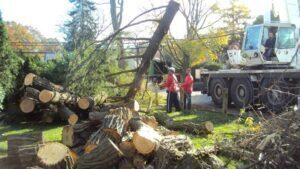How to Cut Down a Tree

7 Steps to Drop in Correct Direction How to Cut Down a Tree If you are trying to cut down a tree in the backyard, it is important to know the steps to take. This article will cover the steps to sound it out, notch the tree, and plan safety escape routes. It will also help you prepare for the inevitable unforeseen incident. Follow the steps in this article to successfully drop a tree in the right direction. This will make the process safer and less hazardous for you and your family. Notching a tree
Before you start notching a tree
you should make two cuts, one on the lower portion of the trunk and the other on the top portion. The first cut should be a 90-degree angle, while the second should be centered about the first cut and connected to the inner portion of the first. The purpose of the cuts is to create a wedge-shaped piece in the direction of the tree’s lean. Generally, the back cut is the most crucial one, as it creates a step that will support the hinge and offset the weight of the tree.
Once you have a proper notch in the tree
you can start to fell it. However, you should be careful when falling a tree. You must always be aware of the possible dangers of splitting a tree, as well as causing it to hit a building or object when it falls in the desired direction. To avoid this, it is better to cut the branches from the backside of the tree rather than from the top.
Using a chainsaw or an axe
is the most common way to cut a notch, but you may also have to use a handsaw or a crosscut saw. While chainsaws are commonly used today, the tools used in the past to make notches were far different. The most popular tools for notching a tree before the 1950s were the axe and the crosscut saw. First, you must make a cut perpendicular to the tree’s grain.
Making a back cut
Having a back cut is essential when cutting down a tree, as it will release most of the tree from the stump, preventing the butt from hitting the operator. A back cut should be made on the opposite side of the trunk, and it should be at least one-inch above the wedge-shaped notch. It is the most
important cut when cutting down a tree
as it will determine whether or not the tree will fall. When making a back cut, you must start from the opposite side of the notch and stop about one-tenth of the tree’s diameter. In some cases, other back cuts may be needed, however, depending on the size of the tree or its location.
To make a back cut, first determine
the direction the tree will fall. Next, determine the amount of lift and back lean that is desired. To do so, right up to the top of the tree with a plumb line and mark the position on the ground. Once you have this information, you will be able to determine the back, lean – the distance from the top of the tree to the apex of the planned undercut. This will be the hinge and pivot point of the falling stem.
Next, consider the natural fall zone
of the tree. You should make a horizontal cut, about one-third of the way into the tree, which is higher than your hips. Then, make another cut on the opposite side of your body, extending about one-third of the way into the tree. Then, the tree will fall perpendicular to this cut. The back cut is critical for avoiding a tree from falling onto the chainsaw.
Sounding it out
You may have heard about the phrase “sounding it out when cutting down a tree.” If you’re considering doing this, there are a few things you should keep in mind. First, make sure you have a plan B in case the tree collapses on you. If possible, run behind another tree. You’ll want to be sure that the tree is dead or hollow before attempting to cut it down. If it is solid and hollow, you may be dealing with live wood and will need to use greater care to protect your belongings.
Planning safety escape routes
When cutting down a tree, plan an escape route in advance. It should be 45 degrees away from the direction in which you’re falling, with the shortest distance of 20 feet. Clear any obstacles that will be in your way of escape, and be sure to retreat in such a way that you won’t have to turn around to face the falling tree. Once you’ve established escape routes, communicate them with everyone working on the site, and be sure to discuss possible hazards with them.
A tree can be heavier than it appears
from below, so be sure to plan for multiple escape routes. Also, plan two escape routes, and make sure to leave a clear area for people to jump into if necessary. This way, if a tree does fall, you’ll be able to safely get away from the scene without causing any damage to nearby trees. Whether you’re felling a tree by yourself, or with a team, plan for several exits.
A safe exit route is essential
to avoid injury or death when you’re cutting a tree. This means that you must cut a side branch first and make your way to the trunk later. You should also consider whether the tree is solid and free of excess lean. To cut the side of a tree without too much lean, plan an escape route that is at least 15 feet away. By calculating side lean and aligning the face cut with the target of the felling tree, you’ll know which side to cut.
Digging a hole twice the size of the existing root ball
If you’re cutting down a tree, you should always dig a hole twice the size of the existing base of the root ball. Tree roots are shallow and run more horizontally than vertically. Over 80% of their root system is within the top 18 inches of soil. By digging a hole twice as large as the existing root ball, you’ll free up the soil and allow the roots to set down faster.
If you’re digging a tree
you must dig a new hole, at least twice the size of the existing root ball. Besides reducing the amount of time the tree is out of the ground, you’ll avoid stressing the roots by cutting too shallowly. You can try to estimate the size of the hole, but it’s usually best to make sure it’s about three feet deep and two feet wide.
To properly plant a tree, you need
to dig a hole that is at least two to three times the size of the existing root ball. To reduce the movement of soil, you can cut the hole into a saucer shape, so that the tree can grow and spread roots easily. You can leave part of the existing soil behind to make the planning process easier and faster.
Falling a tree in the direction it would naturally fall
In the event you’re planning to fell a tree, you may want to fall it in the direction that it would naturally fall. If this happens, you can use a simple method that involves taking the time to study the tree before it’s cut down. In addition to assessing its lean, you should also consider the size and shape of the surrounding area. If you’re planning to fell a tree, make sure to clear an area behind it that will provide an escape route or a safe zone.
You can use this technique
to make sure the tree falls in a direction that would not cause any damage to the surrounding area. To do this, you need to cut a notch in the tree that will be a seventy-degree angle or a zero-to-20-degree angle. When the tree is cut in this way, it will have a notch in the trunk and a hinge at the point where the two cuts meet. Once the tree is cut, the notch will open up in the direction that you want it to fall.
To make a cut in the direction
a tree would naturally fall, start by marking the location where you want the lean to occur. Usually, it is easier to fall a tree in the direction it would naturally fall than in another direction. In cases where a tree leans towards a certain direction, you can compensate by lifting the trunk off the stump, bringing it to the desired direction.
